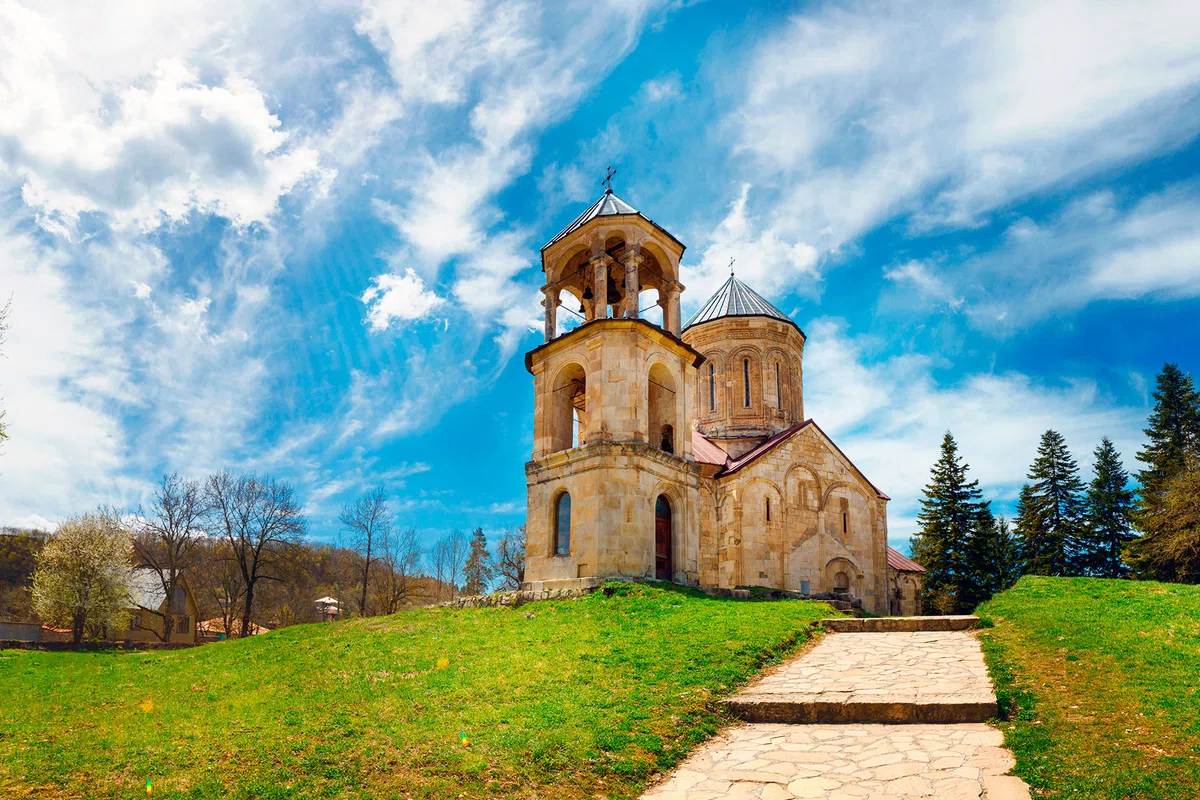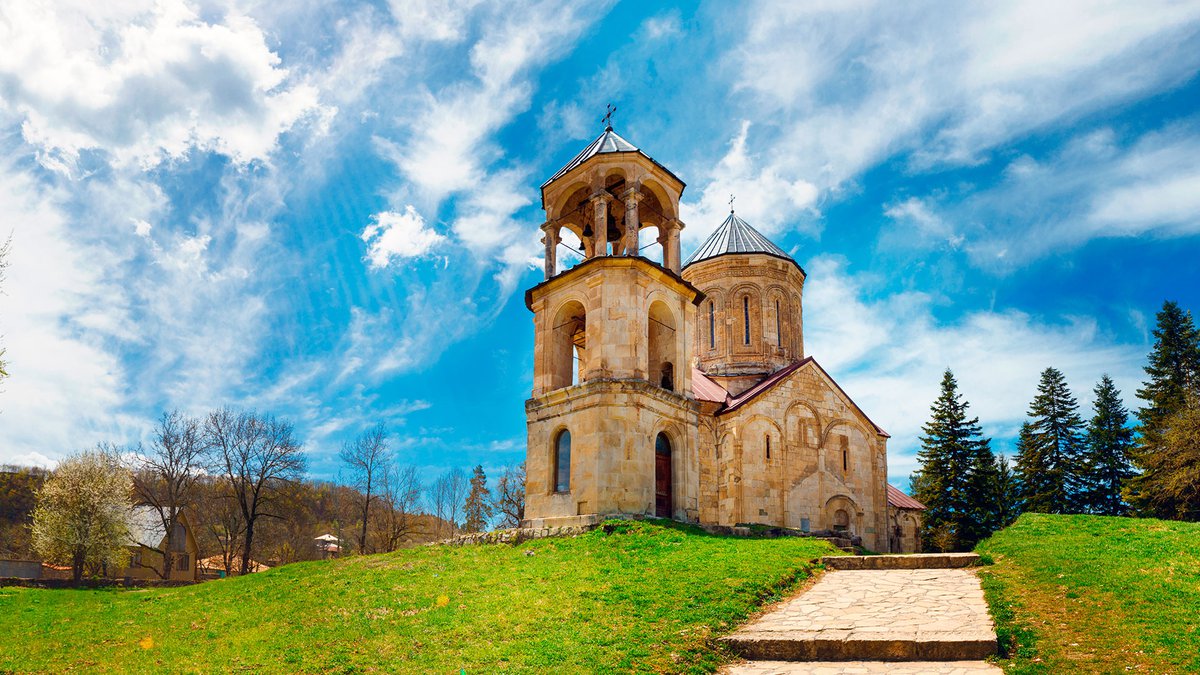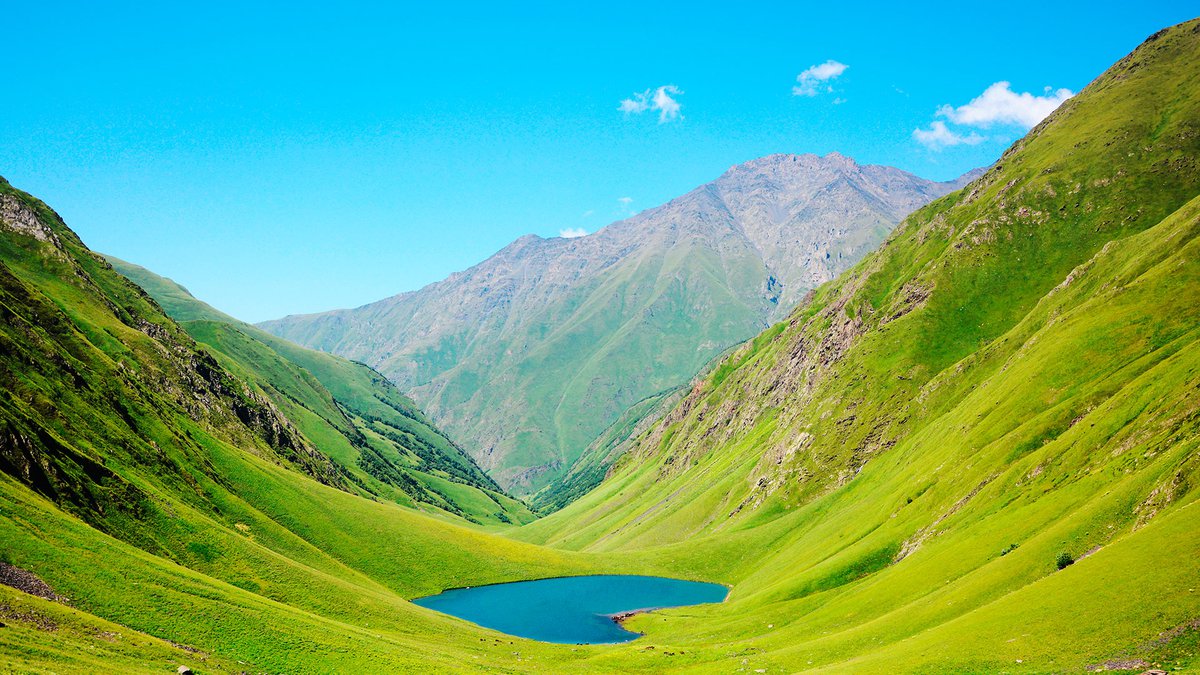
Ancient temples in Georgia. Visit the best attractions. Nikortsminda and barakoni.
There are many beautiful temples in Georgia, but special attention should be paid to the temples of Nikortsminda and Barakoni. Frescoes dating from the sixteenth and seventeenth centuries have been preserved in the interior of the first temple, decorative elements will not leave you without attention. Barakoni is a very significant cultural monument and is the largest cathedral of the eighteenth century.
To the south of Nikortsmid is Shaor reservoir (area 9.2 km2, max. Depth 14, 5). The reservoir appeared in the 50s of the twentieth century, after the Shaori River was dammed. The basin of the reservoir is surrounded by unique green groves with beech trees and Caucasian fir, as well as mixed, deciduous trees.

In the Ambrolaur municipality, not far from the Nakerala pass, on a small hill there is a magnificent domed church named after St. Nicholas - Nikortsminda (or Nikoltsminda, as the locals call it). The village where the temple is located has the same name.
The cathedral was built by the first tsar of the united Georgia Bagrat III in 1010-1014 . In the XI-XIII centuries, the temple served as a monastery for representatives of the Kakhaberidze family — local Eristavs. In the late Middle Ages, it was a tomb for the family of local feudal lords Tsulukidze. Currently it is the center of the Rachin Diocese.
The temple belongs to the type of multi-facade cathedrals and is part of a small group of buildings, the orginal architectural type of which existed in a very limited time frame in the history of the development of Georgian architecture. The layout of the temple is based on the composition of multi-facade cathedrals, when in a single internal space all the apses are located around the central dome space and are not distinguished as separate parts. Frescoes of the XVI-XVII centuries have been preserved in the interior, decorative elements also attract attention: story compositions on the facades, an abundance of complex carvings. The cathedral's outbuildings are also distinguished by various decorative decorations.
Of all the historical monuments that have survived to our time, Nikortsminda is the only one where the reliefs have reached us in their original form. The dome has also been preserved in its original form. During the 1991 earthquake in Racha, the cathedral was damaged, but it has now been restored.
Since October 24, 2007, Nikortsminda Cathedral has been included in the preliminary list of UNESCO World Cultural Heritage Sites.
To the south of the village of Mravaldzali, at the foot of the northern slope of the Rachinsky ridge, near the Soseva locality, there is a lake of karst origin, shaped like a heart. Because of the shape, the locals nicknamed this lake - the Lake of Love. The Khikhat section of the Rachinsky ridge offers a wonderful panorama of the lake, the village of Mravaldzali and the Rachinsky Mountains.

The Barakoni Temple, one of the most significant monuments of Georgian dome architecture of the Middle Ages, is located in Racha, in the Ambloraur municipality, near the village of Tsesi, at the mouth of the Rioni and Luhuni rivers. It was built on the initiative of Rachinsky Eristav Rostom. The ambitious ruler considered himself equal to the Imeretian tsar (disobedience ended tragically in 1769, the Imeretian tsar Solomon I captured Rostom, gouged out his eyes and abolished the Rachin eristavstvo).
Rostom's vanity is evidenced by the scale of the Barakoni temple and its decoration. Barakoni is a domed structure built of hewn stone, is the largest of all the cathedrals erected in Georgia in the XVIII century and is richly decorated with carved ornaments. The architecture of the temple is closely connected with the national traditional architecture. The influence of Iranian culture is not traced here (unlike most of the monuments of Eastern Georgia of this period). The plan of the cathedral is a traditional example of an "inscribed" cross-domed temple, rectangular' with a deep altar apse, with two free domed columns standing, a high dome. The facade is decorated with intricate carved ornaments. The long and eloquent inscriptions tell about the history of the creation of the cathedral, the date is indicated, the names of the customer and the architect are called: from the inscriptions you can find out that the temple was built by architect Avtandil Shulavereli by decree of Rostom in 1753.
As a result of the earthquake of 1991, the temple was severely damaged. Currently, the cathedral has been restored. It is a functioning temple.

To the east of the Barakoni Cathedral, the ruins of one of the most significant monuments of Georgian architecture, the Minda Fortress, have been preserved.













34 comments
Log in to leave a comment
вом храме сохранились фрески 16-17 века.Баракони являются очень значимым и самым большим собором 18 века.Природа вокруг потряса-
ющая, водохранилище, роща из буковых деревьев, пихта, лиственный лес.Тип храма многофасадный, обилие сложной резьбы.Этот храм
стоит посмотреть.В нём сохранились элементы в первозданном виде. В 1991 году храм был повреждён в результате землетрясения, сей-
час собор отреставрирован и является действующим.
Недалеко от перевала Накерала, на небольшом холме стоит храм Святого Николая - Никорцминда.
Собор построил царь Баграт III. В средние века являляющийся усыпальницей для рода местных феодалов Цулукидзе, в настоящее время – центр Рачинской Епархии.
В первоначальном виде сохранился и купол и рельефы. Во время землетрясения 1991 г. поврежден, но реставрирован.
У подножья северного склона Рачинского хребта находится озеро "Любви", в форме сердца. С Рачинского хребта открывается чудесная панорама!
Храм Баракони воздвиг честолюбивый правитель Ростом, посчитавший себя ровней имеретинскому царю, а неповиновение окончилось тем, что царь пленил и выколол ему глаза.
О тщеславии Ростома свидетельствует и убранство, и масштаб храма Баракони, построенного зодчим Автандилом Шулаверели по указу Ростома в 1753 г. То
2007 года внесён в ЮНЕСКО.